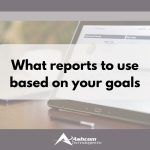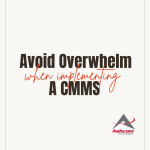Setting up your preventative maintenance (PM) plan doesn’t have to be difficult. It will take some time, but in the end, your department will run better than ever.
Setting up your Preventative Maintenance Plan starts with why—why do you need one? What is the plan’s purpose, and which assets really need it? Your PM plan will need clear and detailed instructions, or standard operating procedures (SOPs). Each asset may have its own set of instructions, and with the help of a computerized maintenance management system (CMMS), you can keep each set tied to each asset. Along with manuals and warranty information, a CMMS is a great tool when setting up your preventative maintenance plan. Once your plan is in place, you can report, track, and adjust as needed.
To start building your PM plan, you’ll want to consider the purpose of PM work specific to your department and its goals. Here are a few examples given by our Director of Business Development, Tim Gelletly:
- Prolong the life of your machine.
- Support the prevention of unplanned breakdowns.
- Keep your machine within the OEM warranty.
- Place your equipment in a state of usefulness/readiness.
Manufacturers that want to court new customers, secure contracts, and grow their business often need to show their prospects that they adhere to PM standards related to their industry. This PM work shows they are capable of producing products within the required specifications.
If your assets fall into one or more of the categories above, you’ll not only want a PM plan, but you will also need one. Any asset essential to daily production needs PM. If it is not essential or is relatively easy or quick to fix, you can leave those assets out of your PM plan. Before starting your PM plan, you may need to determine how to organize your assets and components, which is known as asset hierarchy. Find out why it’s important to have an asset hierarchy in place by reading last month’s blog here.
After you’ve figured out which assets to start on, you’ll need to compile a list of what needs to be done to that asset, how often it needs to be done, and by whom. Some assets come with a standard set of instructions, but you’ll want to add things like where the necessary tools or parts are, who will perform the work, and on what day(s).
SOPs make work fast and efficient and ensure you don’t cut corners or forget items. With MaintiMizer™, we even have a module called Dynamic SOP. Instead of printing a checklist, you can mark off steps completed in MaintiMizer™. You can even save your work halfway through to be picked up later or by another tech. Dynamic SOP can be even more intuitive by routing the work order to the appropriate person or team to resolve any issues as well as handle exceptions to the SOP. Once you close the work order you can finalize the Dynamic SOP so it can’t be edited either.
Once you have your plan in place, it’s time to perform the work, report it, and track it. Inputting the data into the CMMS is only the first step in keeping records on each asset. You can use this data to optimize your plan by building reports to remain compliant with regulations and save money by reducing unplanned downtime or even too much or too little PM work. Align your reporting needs to your purpose. Make sure it all makes sense and cut out anything that doesn’t need to be done to save time and improve efficiency.
If you need more help aligning your preventative maintenance plan with your department and MaintiMizer™, reach out to us at info@ashcomtech.com.

















